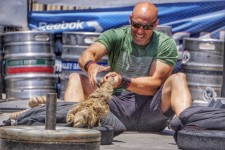
Complete five rounds for time of:
20 Pullups
20 Push-ups
20 Pistols
As a coach when I see this workout, the first thing that comes to mind is a huge opportunity for scaling. But, what is scaling? Scaling is a tool we use to make each movement in question appropriate for the athletes level of fitness or readiness on that particular day. This is a fantastic tool and way to develop movement patterns and strength. We can scale load, reps, rounds, times, and skill.
The athlete I am concerned with right off the bat is not the brand newbie. This athlete usually has clear knowledge that they are in this to learn and start from square one. Scaling is very easy and makes a lot of sense. The athlete that concerns me is the one that has been around for a bit and is aware of scaling and the multiple options available.
Pull-ups are an easy example. A very common way to scale a pull-up is to put bands under the feet, to assist in the reps. Most athletes have their “go to” set of bands that they use for pull-ups. Have these bands changed in the past six months? Is this a conversation that is being had between coaches and athletes? This can quickly become a crutch, which then as far as progress is concerned is negligible.
It’s interesting that people with actual crutches cannot wait to be free of them. Sometimes even to their detriment. The drive to be capable seems to be deeply engrained in us. When it comes to the crutches/scaling options, people are not quite progressing all the time.
So, do we have the tools? We absolutely do. Are we having the conversation? Are we trying to get better? Who is keeping tabs on progress? Or, are we just trying to get through what’s on the whiteboard today?
The conversation is one of longevity. Are we getting better at moving? Are we getting stronger? Are we more capable? Are we using crutches? Or, are we scaling to accomodate progress at a certain skill level? If we are progressing, so should our scaling. Bands should get smaller, movements should get more difficult. Things shouldn’t be easy. Hold yourself to the fire. Hold your coaches to the fire. Ask for help. And, we can do “all the pull-ups!”
Danny Lesslie
@dannylesslie
6/26/15 WOD
Complete the following for time:
800m run
– Rest 4 min –
600m run
– Rest 3 min –
400m run
– Rest 2 min –
200m run
